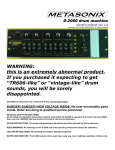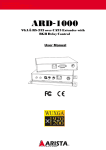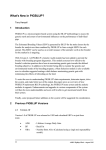Download EMC Troubleshooting in PC Design
Transcript
TROUBLESHOOTING EMC Troubleshooting in PC Design Lv feiyan, Cao Xin, Wang Liang Lenovo (Beijing) Co. Ltd. Abstract Two EMC cases in personal computer (PC) are presented, as one on conducted emission coupled from power port to telecommunication port, the second one on radiated emission derived from poor ground in motherboard. The retrospect of debug and analysis process is illuminated for system EMC design. Keywords EMC debug, PC, telecommunication port, grounding Introduction P outer shield is coupled from the adapter, since the ground (GND) of the adapter output DC terminal is grounded on the enclosure. ersonal Computer (PC) is mostly used in office and home The CE test result is ameliorated as shown in Figure 2. The final environment, sometimes used as controlling center in solution is some capacitances by-passed at the DC output circuit of industry sites. Hence the EMC design for PC should the adapter, as in Figure 3. consider carefully the susceptible instruments surrounding, to reduce the EMI as less as possible to meet Class B level per CISPR 22[1]. PC is built up with CPU, memory, displaying unit and peripherals. The peripheral, sub-assembly parts and motherboard have compatibility issues in the design stage. Troubleshooting is made in light of the whole system, as EMC design and analysis should not impact the host performance. This paper shares two cases in EMC design and debug in PC, fallen into scope of conducted emission (CE) and radiated emission (RE) respectively. Most of the contents are given to describe the Figure 1 CE test result of telecommunication port of EUT intricate process of detecting root cause, and of solution trying, to illuminate the readers. Case 1 - Conducted Emission from the Power Port Coupling to the Telecommunication Port This case is of the influence of common mode CE from the power port especially in the adapter, to the telecommunication port of the host system [2]. In the CE test on telecommunication port, the result shows Figure 2 CE test result of telecommunication port of EUT with reworked adapter failure in the frequency band 3.8~4.5 MHz as Figure 1. The high emission in this band is not influenced by the data rate and format of telecommunication port. The frequency spectrum can be detected with loop antenna at the DC output terminal of the power adapter. Also the same spectrum can be detected on the outer shield of the enclosure of EUT. It is proved that the outer surface current on the 30 SAFETY & EMC 2013 Figure 3 Circuit scheme of the re-worked power adapter of the EUT TROUBLESHOOTING The debug process is tortuous, due mostly to the perfect results victim spectrum disappeared when replacing another type of CPU of other EMC test items which disguised the root cause. The CE heat sink. The new CPU heat sink differs in grounding means of result of power port, and RE result of EUT are all passed. The only screws. When the CPU heat sink has electrical connection with failure is shown in CE of telecom port. Thus the early detection is the fourth layer by grounding of the screws, the RE test failed, see focused on the telecom port of the motherboard. Some solutions Figure 4. So we can see that the dirty EMI on fourth layer is emitted on the motherboard were tried, but in vain. Then the attention was by means of the CPU heat sink. When the grounding of the screws is transferred to the set-ups and peripherals of the CE test, yet the insulated with the fourth layer, the EMI test passed, see Figure 5. alternative tests proved that they had no relation with the failure. The breakthrough occurred when another model of adapter was used in the test and the result turned passed. The near field antenna is employed to detect out the victim spectrum on the output terminal of the suspected adapter, instead of on the motherboard. Thus the real source is found. The suspected adapter, once resulted in curve problem at displaying port of the host system, has a grounding resistance of 10 Ω as R3 in Figure 3 at the protect earthing (PE) line of AC input terminal. If this 10 Ω resistance is removed, the CE test of telecom port will turn passed. However, the curve problem at displaying port Figure 4 RE test result before solution will re-occur. So this 10 Ω resistance can't be removed. The final solution of C30 in Figure 3 is a combination of capacitances of 1 000 pF and 470 pF. It will not impact any other performance of the system. And we see that EMC solution should be the compromised result when considering other functions of the system. Case 2- Radiated Emission Suffered from CPU Heat Sink Grounding The process to figure out the root cause of EMI is always a tough work. The engineer should be expert in the motherboard, not only in layout such as routing, layer division, grounding split, but also in Figure 5 RE test result after solution The final solution including two steps, one is re-configuration of the backboard of the CPU heat sink, as shown in Figure 6. the craft. In this case, the layout scheme is perfect in the blue print, yet a little change of grounding means of the CPU heat sink resulted in EMI over limit at frequency band 800~900 MHz. The peripherals are excluded since it's noticed that the victim EMI is not derived from I/O ports of the EUT. During the RE test, the victim EMI occurs when the displaying port is activated with full screen of characters. Thus the data transferring between CPU and memory card is suspected. The routing in Gerber file is checked to find that there're four pairs of high speed lines for graphic function, with 3 pairs running at top layer of the motherboard, while the Figure 6 Re-configuration of the backboard of the CPU heat sink The second is that the metal set up of the screw holes is changed as Figure 7. The two steps guarantee the effect in mass production. fourth pair is routing at the bottom layer. The fourth pair of lines is The screw of CPU heat sink is only one small part of thermal not grounded at GND, but on reference voltage port Udimm. Thus, the design, yet its effect on EMI performance is magnified when bottom layer is noisy. stimulated by the little re-arrangement of grounding point in ground The root cause is explored, but there's no time to return the layer. This case reminds the R&D engineers that system design motherboard to re-routing. Finally the engineer found that the should concern beyond the circuit scheme to the realizing technique SAFETY & EMC 2013 31 TROUBLESHOOTING practically. Filtering and grounding is aimed at root cause. For filtering, the magnetic coils or capacitance is frequency selective so that many tests might be tried before the right one is found. Grounding is the best way for both solution and cost, yet it needs experienced estimation on where and with what means to ground. Many EMC analysis models are abstracted from complicated system, with many elements omitted. Such models are popular Figure 7 Improved metal set-up of the grounding screw of CPU heat sink details. It's the representative case in EMC that a slight modification on one part may affect the whole system. Conclusions in many textbooks. Yet the magic of EMC troubleshooting lies in the process of detecting root cause when passing through many specious factors. Even the source is found, the solution is more than one means. The engineer should consider both the cost and the easy reproduction in mass. The final one is preferred that is costcontrolled and easily put into mass production in manufacturing assembly. There're three types of EMC solution as grounding, filtering and shielding. Shielding is to cut off the EMI transferring, without References getting rid of the interference source from the root. So if the root [1] cause is in the motherboard, the same over-limit failure will re-occur when the motherboard is employed in another computer CISPR 22 Information technology equipment-Radio disturbance characteristics - Limits and methods of measurement[S].2008. [2] Lv Feiyan, Caoxin, Zhou Hui. Influencing Factors in Conducted system to require the second re-work. Besides, shielding material Disturbance Test for Telecommunication Port According to GB 9254- will result in cost-up. So shielding is always the last choice 2008[J], Safety & EMC,2009,4: 17-22. 32 SAFETY & EMC 2013








